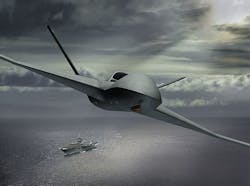Congress wants Navy to beef-up offensive strike capabilities of UCLASS unmanned aircraft
Carrier air group commanders want an unmanned bomber on the flight deck, not just a new reconnaissance drone, and tight budgets have forced program managers to cut out a lot of air-to-ground capability, rendering UCLASS essentially a carrier-based surveillance platform.
Now Congress is starting to get involved, where lawmakers are voicing similar concerns. Instead of a stealthy deep-penetrating strike aircraft as originally conceived, Navy program managers reportedly have changed UCLASS requirements to conduct intelligence, surveillance, and reconnaissance (ISR) missions over uncontested airspace with only a light secondary strike capability.
Members of the House Armed Services Committee are threatening to hold up UCLASS program funding until that changes. This could delay the program for a year or more, and could be the catalyst either to improving the UCLASS concept or getting the program scrapped altogether.
Related: Navy gets wheels in motion to start official competition to build carrier-based combat UAV
Committee members have introduced a bill to hold up UCLASS funding until Defense Secretary Chuck Hagel conducts a study for a future carrier-unmanned strike aircraft. The legislation is part of the committee's first version of the 2015 National Defense Authorization Bill.
The study due to Congress by the end of the year, would focus on requirements for a carrier-based unmanned aerial system to extend the ISR and precision-strike reach of the carrier air wing in the presence and determined defense of the enemy.
At least part of the issue has to do with the military's current fleet of unmanned aerial vehicles (UAVs). Many leaders believe, in short, that military forces have enough surveillance UAVs that can operate in contested airspace; what the Navy needs is a stealthy penetrating aircraft with substantial offensive punch.
That's not how the program is structured currently, with four of the nation's leading UAV designers set to bid on the final UCLASS design. Bidders will be the Boeing Co. Defense, Space & Security segment in St. Louis; the Lockheed Martin Corp. Skunk Works in Palmdale, Calif.; General Atomics Aeronautical Systems Inc. in Poway, Calif.; and the Northrop Grumman Corp. Aerospace Systems segment in Redondo Beach, Calif.
If the House Armed Services Committee's language ends up in the final 2015 National Defense Authorization Bill, that will mean Congress will draw the purse strings shut on the program until the Navy and the Pentagon can restructure the program sufficiently to include offensive capability for missions like suppression of enemy defenses, electronic attack, and precision strike, in addition to ISR.

